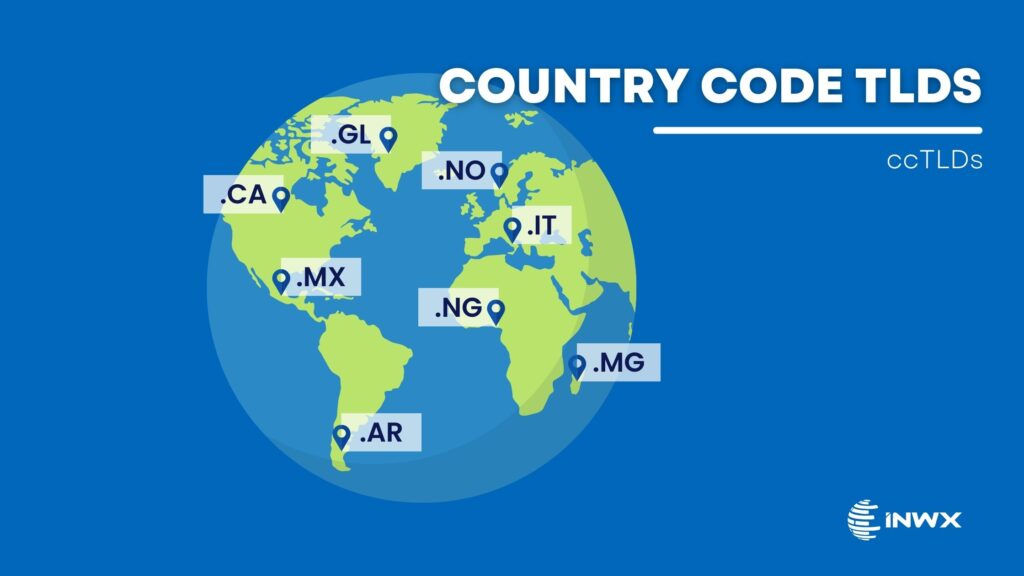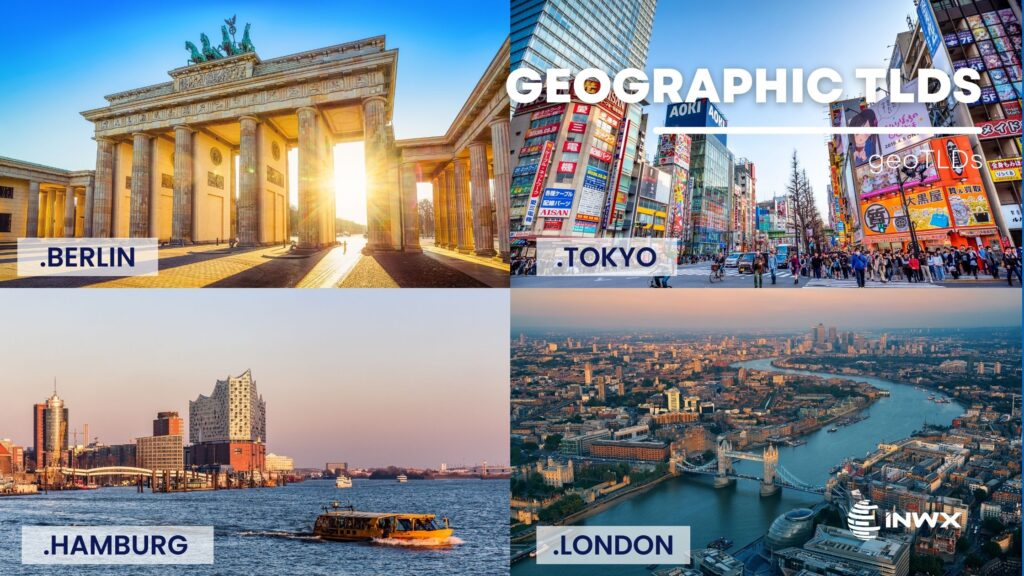In this article, you will find out what a top-level domain (TLD) is and what types of TLDs there are.
Overview of top-level domains (TLDs)
A top-level domain (TLD) is the ending of a domain. E.g. .DE, .AT, .COM or .NET. It is always on the far right after the last dot. In the domain www.inwx.de, for example, the ending “.DE” is the top-level domain.
There are basically two types of top-level domains:
- Country code top-level domains (ccTLDs) such as .DE
- Generic top-level domains (gTLDs) such as .COM.
What top-level domains are there?
Basically, all domain endings can be divided into two groups: The country-specific and the generic TLDs.
Country-specific TLDs are two-letter domain extensions that specifically stand for a country or a dependent territory. These TLDs are usually assigned to a specific nation and are often used by people or companies that have a strong connection to or operate in that particular country. An example is the .DE domain for Germany.
Generic TLDs are not tied to a specific country and are open to a wider audience. They are often chosen based on the type of website – for example, .COM is traditionally used for commercial businesses, while .ORG is often chosen by non-profit organizations.
In the past, the choice of available TLDs was relatively limited, but recent policy changes have turned the tide. Today, there are well over a thousand different TLDs in these two main categories, with a significant proportion of the newly available options falling into the generic TLD category. Below, I will give you a brief overview of the different types of country code and generic TLDs.
Country code top-level domains (ccTLDs)

Country domain extensions, also known as ccTLDs (Country Code Top-Level Domains), are based on the two-letter ISO codes, each of which is assigned to a country or territory. There are currently over 300 such ccTLDs worldwide. Some ccTLDs require a residence or presence in the respective country for registration, while others are available to anyone worldwide without such restrictions.
Examples of ccTLDs are:
- .DE for Germany
- .FR for France
- .US for the USA
It should be noted that some ccTLDs have been misappropriated. One example is the .AI domain, which was originally assigned to the British overseas territory of Anguilla in the Caribbean. Today, it is mainly used for internet presences related to artificial intelligence.
Internationalized country-code domains (IDN ccTLDs)
In addition to the conventional ccTLDs, there are also internationalized domain names (IDN ccTLDs) that make it possible to use country domains in local writing systems. These are particularly important in countries where non-Latin characters are used.
The largest IDN ccTLDs include:
- .рф for Russia
- .台灣for Taiwan
- .中国 for China
These domains allow users to write and recognize web addresses in their own script, which significantly improves accessibility and localization on the Internet.
Generic TLDs (gTLDs)
General or generic domain endings do not belong to any country, but each have a topic-related meaning. In contrast to country-specific TLDs, which usually consist of two letters, gTLDs always have at least three letters.
Before the ICANN guidelines were updated, there were only 22 gTLDs. Today, there are over 1,200 different gTLDs to choose from. This expansion allows for greater flexibility and personalization for website operators, opens up creative possibilities for online branding and ensures that domain names better match the content and character of the website.
The generic TLDs can be historically divided into
- sponsored
- and non-sponsored domain extensions
can be divided. While non-sponsored TLDs operate under general policies set directly by the global Internet community through the ICANN process, sponsored TLDs are targeted at specific communities and are managed and funded by them.
Non-sponsored TLDs (uTLD)
These TLDs are generally available and not restricted to a specific community or industry.
Unsponsored top-level domains (unsponsored TLDs) were originally intended for use by specific communities or industries. Unlike sponsored TLDs, which are often managed by an independent agency, unsponsored domains are under the direct supervision of ICANN and the Internet Society. These institutions are responsible for overseeing and coordinating these domains, ensuring that they are in line with the global policies of the Internet and its governance structure.
Some examples of unsponsored TLDs are:
- .COM
- .INFO
- .NET
- .ORG
Sponsored TLDs (sTLD)
Sponsored TLDs are managed by a specific community or industry, which also sets the rules for the use of these domains.
Sponsored top-level domains (sTLDs) are managed by specific organizations or interest groups that also finance these domains. These sponsors have the possibility to define their own rules for the allocation of domains, which are often adapted to the needs and criteria of their specific community.
Some examples of sponsored TLDs (sTLDs) are:
- .AERO (aviation industry)
- .EDU (educational institutions, mainly in the USA)
- .MUSEUM (museums)
- .COOP (cooperatives)
- .JOBS (human resources management)
Another striking example is the .MIL domain, which is used exclusively by the US military and whose allocation is strictly regulated
New TLDs (nTLD)

The introduction of new TLDs (nTLDs) from 2013 marks a significant milestone in the development of the Internet. This measure served to expand the selection options for web addresses and to meet more specific requirements. The nTLDs encompass a wide range of options, including industry, interest and community-specific domains that allow organizations and individuals to more precisely tailor their online presence and stand out from others.
With the introduction of new gTLDs in 2012, the domain landscape changed dramatically. Most of the new gTLDs are in fact sponsored domains controlled by corporations, marking a new era of brand presence online. These new TLDs include all TLDs launched since the start of ICANN’s new gTLD program in 2013. ICANN has discontinued the distinction between sponsored and non-sponsored TLDs for the new gTLDs in this round, making the distinction between the two categories less strict.
Here are some examples of new TLDs:
- .TECH
- .BLOG
- .PHOTO
- .IMMOBILIEN
Among the new TLDs there are also special types:
- Geographical TLDs
- Internationalized gTLDs
- Brand TLDs
You can find out more about them below.
Geographic TLDs (geoTLD)

Geographic TLDs (geoTLDs) are one of the innovations in the domain name space that target specific geographic, urban or regional identities. They allow cities, regions and even entire countries to emphasize their digital presence with a clearly recognizable web address that reflects their heritage, culture or geographic location.
Some examples of geoTLDs are:
- .BERLIN
- .HAMBURG
- .BAYERN
- .LONDON
- .TOKYO
These TLDs are often managed by local authorities or organizations that have an interest in representing and promoting their communities online.
Internationalized TLDs (IDNs)
Internationalized TLDs (IDNs) represent an important development in the domain name space by enabling the use of non-Latin writing systems. This opens up the Internet to a global user base as people can now register domains in scripts such as Cyrillic, Chinese, Arabic or other local scripts.
Some examples of internationalized generic top-level domains (gTLD IDNs) are:
- “.企业” (xn--vhquv), which means “company” in Chinese.
- “.संगठन” (xn--i1b6b1a6a2e), which means “organization” in Hindi.
- “.орг” (xn--c1avg), the Cyrillic version of “.org”.
These gTLDs expand the Internet by allowing users to use domains in a variety of world alphabets, promoting linguistic diversity on the global network.
Brand gTLD
Brand gTLDs are an innovation in the domain name system that allows companies to strengthen their brand presence online through a unique, brand-specific top-level domain. These customized endings offer brands the opportunity to build a cohesive and controlled digital ecosystem. By using these special domains, companies can clearly emphasize their brand identity online and establish a more direct connection with customers, partners and stakeholders.
Examples of brand gTLDs are:
- .BMW
- .APPLE
A special case – the infrastructure domain (iTLD)
The special case TLD .ARPA is also historically counted among the generic TLDs. It dates back to the early days of the Domain Name System and is still used today as an infrastructure domain.
You can find out more about the first top-level domains in this article.
How do TLDs work?
Top-level domains (TLDs) are a fundamental part of the Domain Name System (DNS) that structures the Internet.
The Domain Name System is responsible for translating readable domain names into numerical IP addresses that computers use to locate Internet resources. Each TLD is referenced in the DNS and assigned to a unique IP address. When a domain is registered, the domain name registrar creates a database entry about the owner, which can then be queried via the Whois protocol – this is similar to how a telephone directory works.
TLDs, or top-level domains, are the last component in a domain name, following the last dot. They represent the highest level in the DNS hierarchy and are used to organize Internet addresses. “Top-level domain” means something like “top-level area”.
If you think of the analogy with the telephone directory, this means the following: The TLDs are, so to speak, the surnames of the individual domains – all domains with the .DE extension are like a family living in the same house or server. This means that your browser can quickly find the correct address for the content of a website by first checking the last name (TLD) and then the corresponding first names (e.g. second and third level domains).
Why are there so many different TLDs?
Top-level domains (TLDs) were originally introduced with a clear and specific purpose, and the choice was initially very limited. Over time, the restrictions have loosened, especially with the introduction of ICANN’s “New gTLD Program” in 2011. This program allowed organizations and companies to apply for their own unique TLDs, resulting in a significant expansion of available domain extensions.
In 2020, according to ICANN, there were over 1,500 TLDs and more are being added all the time.
This expansion has greatly boosted the diversification of options available to end users and domain investors.
What relevance does the choice of TLD have for SEO?
The choice of a domain extension is often related to costs, personal preferences and branding. But you should also consider the impact on search engine rankings when deciding on a domain extension.
Although the choice of top-level domain (TLD) has no direct influence on search engine rankings, it can indirectly affect search results and user trust. While keywords in the TLD itself do not improve rankings, country-code TLDs (ccTLDs) tend to rank better in local search results than generic TLDs (gTLDs).
When choosing a TLD creatively, you should pay attention to whether a gTLD is actually a registered ccTLD, such as .li, which actually stands for Liechtenstein. If the website does not have the relevant country as a target market, this could influence ranking factors or lead to problems. However, Google treats some ccTLDs, such as .io and .fm, as gTLDs due to their generic use. The decision for a TLD should therefore be made carefully in order to maximize the SEO potential of the website and avoid confusion or misunderstandings among users.
Do you still have questions?
I hope you enjoyed this article. Want to learn more about domains? Then take a look at our article “What Types of Domains are there? – An Overview“.
And if you still have questions, just send us an email to blog@inwx.de.

